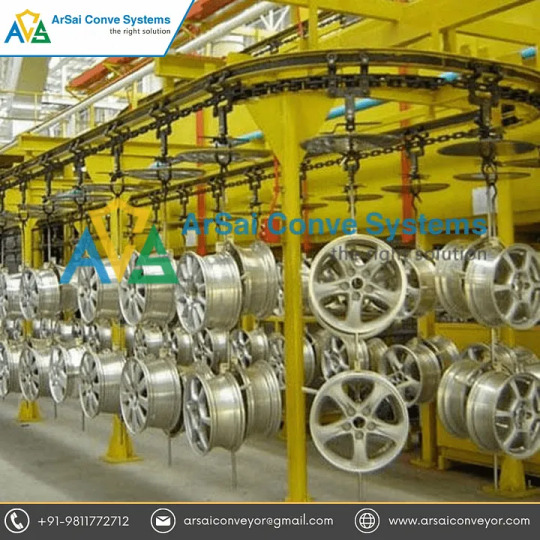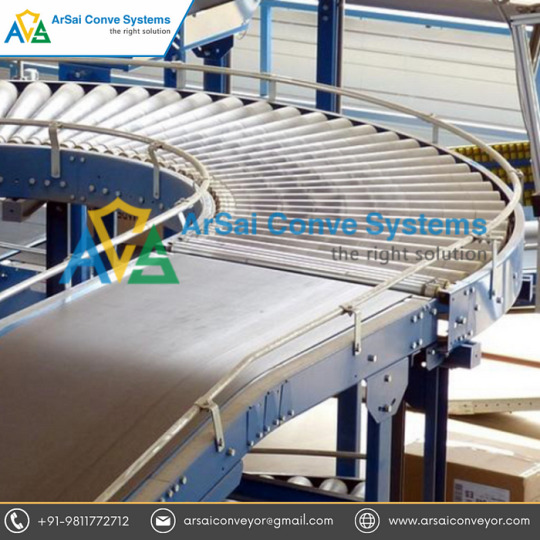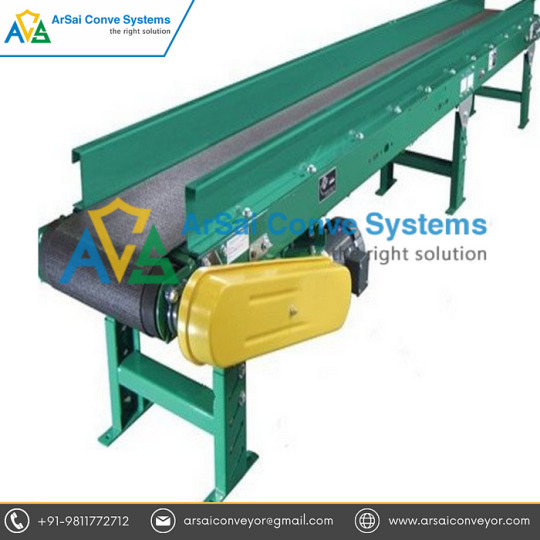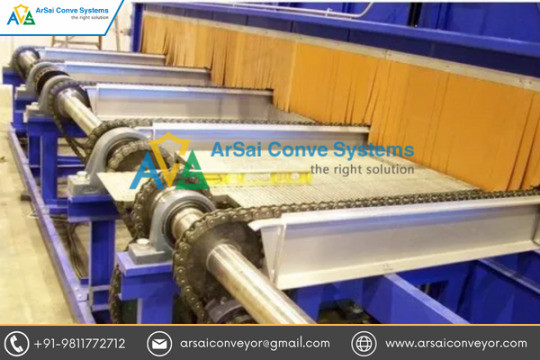Text
Overhead Conveyors Manufacturer in India
Are you Looking for Overhead Conveyors Manufacturing Company in India? ArSai Conve Systems

With a commitment to delivering cutting-edge solutions, ArSai Conve Systems boasts a comprehensive range of overhead conveyors tailored to meet diverse industrial needs. Whether you’re in the automotive, food processing, or logistics sector, they have you covered.
What sets ArSai Conve Systems apart is not just their products but also their unwavering dedication to customer satisfaction. Their team of experts works closely with clients to understand their specific requirements and offer customized solutions that exceed expectations.
In conclusion, if you’re in search of a reliable overhead conveyor solution provider in India, ArSai Conve Systems should be your go-to choice. With their commitment to quality, customization, and customer satisfaction, they are poised to take your business to new heights.
Contacting ArSai Conve Systems is a breeze. You can reach them via phone at +91–9811772712 or +91–9810773412. Alternatively, drop them an email at [email protected] or [email protected]. Their headquarters are conveniently located at Kh. No.- 74, Morta Industrial Area, Delhi-Meerut Road, Ghaziabad- 201001, UP.
0 notes
Text
What is the working principle of a belt conveyor?
A Belt conveyor is a marvel of engineering simplicity, yet its functionality is paramount in the smooth operation of material handling processes. Picture a continuous loop of material, typically rubber or fabric, wrapped around two or more pulleys. These pulleys are powered by motors, setting the belt in motion along a predetermined path.

Key Components and Their Roles:
Belt: The belt itself is the conveyor’s workhorse, carrying the load from one point to another. It needs to be durable, flexible, and capable of withstanding the rigors of industrial environments.
Pulleys: These are the driving force behind the conveyor. Motorized pulleys, often located at both ends of the conveyor, provide the necessary torque to move the belt. The size and configuration of the pulleys determine the speed and direction of the conveyor.
Idlers: Idlers or rollers support the belt, reducing friction and ensuring proper alignment. They are strategically placed along the conveyor’s length to maintain stability and prevent sagging.
Frame Structure: The frame serves as the conveyor’s skeleton, providing support and stability. It’s typically constructed from sturdy materials like steel or aluminum, designed to withstand heavy loads and harsh operating conditions.
Working Principle of a Belt Conveyor:
The operation of a belt conveyor can be broken down into several straightforward steps:
Loading: Materials are loaded onto the conveyor belt at the loading point, either manually or via automated systems like chutes or hoppers.
Transportation: The motorized pulleys drive the belt forward, causing it to move along its designated path. As the belt progresses, it carries the materials with it, transporting them to their destination.
Unloading: Once the materials reach their intended destination, they are unloaded from the conveyor belt. This can be achieved through gravity, where the materials simply slide off the end of the belt, or through mechanical means such as diverters or robotic arms.
Advantages of Belt Conveyors:
Efficiency: Belt conveyors offer a continuous and automated means of transporting materials, resulting in high throughput rates and improved productivity.
Versatility: These conveyors can handle a wide range of materials, from small components to bulky items, making them suitable for various industries and applications.
Safety: When properly designed and maintained, belt conveyors provide a safer alternative to manual material handling, reducing the risk of workplace accidents and injuries.
Cost-Effectiveness: With minimal maintenance requirements and a long service life, belt conveyors prove to be a cost-effective solution for material handling needs.
Conclusion:
In conclusion, the working principle of belt conveyors may seem deceptively simple, but its impact on industrial operations is profound. By efficiently and reliably transporting materials, these conveyors play a vital role in optimizing logistical processes and driving productivity. As we continue to innovate and refine material handling technologies, belt conveyors remain steadfast as indispensable assets in the modern industrial landscape.
Best Belt Conveyor Manufacturer in India
If you are looking for a Belt Conveyor Manufacturers in India, look no further than Arsai Conveyor Systems Private Limited, We are a leading manufacturer and supplier of Belt Conveyor in India.
For more details, please contact us!
Website — https://www.arsaiconveyor.com/belt-conveyor/
Contact No. — +91–9811772712
Email — [email protected]
#Belt Conveyor Manufacturers in India#Belt Conveyor Manufacturer#Belt Conveyor Supplier in India#Belt Conveyor Manufacturers in Delhi NCR#Belt Conveyor Manufacturers in Noida#Belt Conveyor Manufacturers in Gurugram#Top Belt Conveyor Manufacturers in India
1 note
·
View note
Text
Are you Looking for Overhead Conveyors Manufacturing Company in India? ArSai Conve Systems
If you’re on the hunt for a top-tier overhead conveyor manufacturer in India, look no further than ArSai Conve Systems. Renowned for their excellence in the field, ArSai Conve Systems stands as a beacon of quality and reliability in the industry.

Overhead Conveyor Manufacturer
With a commitment to delivering cutting-edge solutions, ArSai Conve Systems boasts a comprehensive range of overhead conveyors tailored to meet diverse industrial needs. Whether you’re in the automotive, food processing, or logistics sector, they have you covered.
What sets ArSai Conve Systems apart is not just their products but also their unwavering dedication to customer satisfaction. Their team of experts works closely with clients to understand their specific requirements and offer customized solutions that exceed expectations.
Contacting ArSai Conve Systems is a breeze. You can reach them via phone at +91–9811772712 or +91–9810773412. Alternatively, drop them an email at [email protected] or [email protected]. Their headquarters are conveniently located at Kh. No.- 74, Morta Industrial Area, Delhi-Meerut Road, Ghaziabad- 201001, UP.
In conclusion, if you’re in search of a reliable overhead conveyor solution provider in India, ArSai Conve Systems should be your go-to choice. With their commitment to quality, customization, and customer satisfaction, they are poised to take your business to new heights.
#Overhead Conveyor#Overhead Conveyor Manufacturer#Overhead Conveyor Manufacturers#Overhead Conveyor Manufacturing#Overhead Conveyor Manufacturer in India#Overhead Conveyor Manufacturer in Ghaziabad
0 notes
Text
Advantages of Roller Conveyors in Material Handling
A roller conveyor is a material handling system comprising parallel-mounted rollers on frames, forming a continuous surface for the efficient movement of goods within industrial environments. It can be powered by external motors or gravity, making it versatile for various applications like parcel sorting, assembly line transportation, and pallet handling in warehouses. Roller conveyors are known for their simplicity, low maintenance, and ability to handle diverse materials, providing a cost-effective solution for streamlined material handling.

Uses of Roller Conveyors:
Parcel and Package Sorting: Roller conveyors find extensive use in parcel and package sorting facilities. The gravity-driven rollers allow for a smooth and controlled movement of packages, aiding in the efficient sorting of items based on size, destination, or other criteria.
Assembly Line Dynamics: Roller conveyors play a vital role in assembly lines, where the systematic movement of components is crucial for the manufacturing process. Their ability to transport items without the need for external power makes them ideal for gravity-fed applications, contributing to the optimization of assembly line workflows.
Pallet Handling in Warehouses: Warehouses benefit from roller conveyors for handling pallets and larger loads. These conveyors provide a reliable means of transporting heavy items over short or long distances, contributing to the streamlined operations of material distribution within a facility.
Dynamic Material Accumulation: Roller conveyors can be designed to allow for the accumulation of materials without the need for external power. This feature is particularly useful in scenarios where temporary halts or buffering are required in the material handling process.
Advantages of Roller Conveyors:
Simple and Low-Maintenance Design: The straightforward design of roller conveyors, often driven by gravity, contributes to their low maintenance requirements. With fewer components prone to wear and tear, these conveyors offer a cost-effective solution for material handling needs.
Versatility in Material Handling: Roller conveyors are versatile and can handle a wide range of materials, from small packages to larger items. Their adaptability makes them suitable for various industries, contributing to the flexibility and efficiency of material handling operations.
Energy Efficiency: Gravity-driven roller conveyors operate without the need for external power, relying on the natural force of gravity for movement. This not only reduces energy consumption but also aligns with the growing emphasis on sustainable and eco-friendly practices in industrial settings.
Customizable Configurations: Roller conveyors can be easily customized to suit specific material handling requirements. Whether it’s the roller spacing, conveyor length, or the addition of curves, businesses can tailor these systems to optimize the flow of materials within their unique operational contexts.
Conclusion:
In conclusion, roller conveyors stand as silent champions in the realm of material handling, offering a reliable and efficient solution for various industries. Their simple design, low-maintenance requirements, and adaptability make them indispensable tools in the pursuit of streamlined logistics. As industries continue to evolve, roller conveyors are likely to remain at the forefront, contributing to the ongoing transformation of material handling processes.
#roller conveyor#roller conveyor manufacturer#roller conveyor supplier#roller conveyor manufacturer in India#roller conveyor supplier in India
1 note
·
View note
Text
Advantages of Floor Conveyors in Industrial Operations
Introduction:
In the dynamic world of industrial automation, floor conveyors stand tall as silent heroes, orchestrating the seamless movement of materials across manufacturing floors and distribution centers. These ingenious systems have become integral to modern material handling, offering a myriad of benefits that contribute to increased efficiency and productivity. This blog explores the uses and advantages of floor conveyors, shedding light on their transformative role in shaping the landscape of industrial logistics.

Uses of Floor Conveyors:
Assembly Line Precision: Floor conveyors play a pivotal role in assembly lines, ensuring a continuous and controlled flow of components. From the automotive industry to electronics manufacturing, these conveyors facilitate the precise movement of parts, reducing manual handling and enhancing production accuracy.
Warehousing and Distribution: In vast warehouses and distribution centers, floor conveyors streamline the movement of goods, optimizing the order fulfillment process. They are adept at handling a diverse range of products, from small items to larger packages, contributing to the overall efficiency of logistics operations.
Heavy-Duty Material Transport: Floor conveyors are designed to handle heavy loads with ease. This makes them indispensable in industries dealing with bulk materials, such as mining and construction, where the continuous and reliable transportation of heavy items is a key factor in operational success.
Customized Solutions: The versatility of floor conveyors allows for customization to suit specific industry needs. Whether it’s a straight-line conveyor, a curved path, or an intricate network of interconnected systems, these conveyors can be tailored to optimize material flow according to the unique requirements of a facility.
Advantages of Floor Conveyors:
Space Optimization: Unlike traditional material handling systems, floor conveyors operate at ground level, eliminating the need for overhead structures. This results in space optimization within the facility, allowing for a more flexible layout and efficient use of available space.
Reduced Labor Costs: Floor conveyors automate the movement of materials, reducing the reliance on manual labor. This not only minimizes the risk of injuries associated with heavy lifting but also contributes to significant cost savings by optimizing workforce utilization.
Enhanced Safety Measures: With floor conveyors, the risk of accidents related to material handling is mitigated. These systems are equipped with safety features such as emergency stops, sensors, and guards, ensuring a secure working environment for operators and other personnel.
Increased Productivity: The continuous and automated nature of floor conveyors leads to enhanced productivity. By eliminating bottlenecks, minimizing downtime, and optimizing material flow, these conveyors contribute to a more efficient and streamlined manufacturing or distribution process.
Conclusion:
In conclusion, floor conveyors have emerged as indispensable tools in the realm of industrial material handling. Their ability to efficiently transport materials, adapt to diverse industry needs, and contribute to space optimization makes them key players in the pursuit of operational excellence. As industries continue to evolve, the role of floor conveyors is likely to expand, ushering in a new era of efficiency and innovation in material handling processes.
1 note
·
View note
Text
Benefits of Flat Belt Conveyors in Material Handling
A flat belt conveyor is a mechanical system designed for horizontal material transportation within industries. It features a continuous flat belt moving over pulleys or rollers, powered by a motor. Versatile and widely used, flat belt conveyors efficiently transport bulk materials, components in manufacturing, packaged goods in warehouses, and luggage in airports. Their simple design, ease of customization, and cost-effectiveness make them integral to streamlined material handling processes in various sectors.

Uses of Flat Belt Conveyors:
Bulk Material Handling: Flat belt conveyors are widely employed for transporting bulk materials such as grains, ores, and raw materials in industries like agriculture and mining. The continuous surface of the flat belt allows for a smooth and efficient flow of materials over long distances.
Manufacturing and Assembly Lines: In manufacturing processes, especially in industries like electronics and food production, flat belt conveyors play a crucial role in the movement of components along assembly lines. Their flat, unobstructed surface ensures that even delicate items can be conveyed without the risk of damage.
Packaging and Warehousing: Flat belt conveyors are used in packaging lines for the orderly and automated movement of packaged goods. Warehouses also benefit from these conveyors for efficient order picking and sorting of products, optimizing logistical operations.
Airport Baggage Handling: Airports leverage flat belt conveyors in their baggage handling systems, streamlining the journey of passenger luggage from check-in to the aircraft. The flat surface of the belt ensures smooth and reliable transport of bags of varying sizes.
Advantages of Flat Belt Conveyors:
Versatility and Adaptability: Flat belt conveyors are known for their versatility, accommodating a wide range of materials and applications. They can be easily adapted to suit specific industry requirements, making them an ideal choice for diverse material handling needs.
Ease of Maintenance: With a straightforward design comprising a flat surface and pulley system, flat belt conveyors are relatively easy to maintain. This simplicity translates into reduced downtime and lower maintenance costs, contributing to increased operational efficiency.
Cost-Effectiveness: Flat belt conveyors offer a cost-effective solution for material handling, making them an attractive option for businesses aiming to optimize their operational expenses. The initial investment is often offset by long-term savings in maintenance and labor costs.
Quiet and Energy-Efficient Operation: The smooth, continuous motion of flat belt conveyors results in quiet and energy-efficient operation. This not only creates a more conducive work environment but also aligns with the growing emphasis on sustainable and eco-friendly practices in modern industries.
Conclusion:
In the world of material handling, flat belt conveyors stand out as versatile, cost-effective, and efficient solutions. From transporting bulk materials to facilitating the movement of delicate components on assembly lines, these conveyors have proven their worth across diverse industries. As technology continues to advance, flat belt conveyors will likely remain at the forefront, contributing to the ongoing evolution of streamlined and efficient material handling systems.
#flat belt conveyor#flat belt conveyor manufacturer#flat belt conveyor manufacturer in India#flat belt conveyor manufacturer in Delhi NCR#flat belt conveyor supplier#flat belt conveyor supplier in India
1 note
·
View note
Text
Uses and Advantages of Chain Conveyor
A chain conveyor is a mechanical system designed for automated material handling in industrial settings. It consists of interconnected chains running on sprockets, facilitating the continuous and reliable movement of goods or materials. Widely used in manufacturing and distribution, these conveyors are known for their durability, versatility, and ability to handle heavy loads. They offer customization options, reducing manual labor, minimizing downtime, and optimizing material flow, thereby enhancing overall operational efficiency in various industries.

Uses of Chain Conveyors:
Material Handling in Manufacturing: Chain conveyors play a pivotal role in manufacturing processes by efficiently transporting raw materials, components, and finished products from one point to another. They ensure a smooth flow of materials, reducing manual handling and enhancing overall production efficiency.
Automated Assembly Lines: In industries where precision and speed are paramount, chain conveyors are employed to facilitate the movement of products along assembly lines. This helps streamline the production process, allowing for consistent and timely assembly of intricate components.
Distribution and Warehousing: The logistics and distribution sector heavily relies on chain conveyors to handle the seamless movement of packages and goods within warehouses. These systems can be customized to suit the specific needs of different industries, enabling efficient order fulfillment and timely dispatch of products.
Automotive Industry: In the automotive sector, where precision and efficiency are crucial, chain conveyors are used for transporting vehicle parts during the manufacturing process. This ensures a continuous and reliable flow of components, contributing to the overall productivity of the assembly line.
Advantages of Chain Conveyors:
Reliability and Durability: Chain conveyors are known for their robust construction, making them highly reliable in demanding industrial environments. The durable chains and sprockets used in these systems contribute to their long lifespan and minimal maintenance requirements.
Versatility: Chain conveyors are incredibly versatile and can be adapted to suit a wide range of applications. They can handle various types of materials, including bulk items, heavy loads, and irregularly shaped products, making them suitable for diverse industries.
Customization Options: These conveyors offer extensive customization options, allowing businesses to tailor the system to their specific needs. Whether it’s the size, speed, or configuration, chain conveyors can be designed to optimize the workflow within a particular facility.
Efficient Material Flow: The continuous and automated nature of chain conveyors ensures a smooth and efficient flow of materials. This not only reduces the risk of bottlenecks but also enhances overall productivity by minimizing downtime and optimizing resource utilization.
Cost-Effective Solution: Chain conveyors are a cost-effective solution for material handling, especially when compared to alternative methods like manual labor or other conveyor systems. The initial investment is often offset by the long-term savings in labor costs and increased operational efficiency.
Conclusion:
In conclusion, chain conveyors have become indispensable in modern industries, offering a reliable and efficient solution for material handling. Their versatility, durability, and customizable features make them a preferred choice for businesses aiming to enhance their production processes and streamline logistics. As industries continue to evolve, chain conveyors will undoubtedly play a vital role in shaping the future of automated material handling systems.
#chain conveyor#chain conveyor manufacturer#chain conveyor system manufacturer#chain conveyor system supplier#chain conveyor supplier in India#chain conveyor manufacturer in India
2 notes
·
View notes